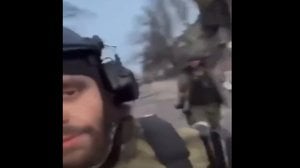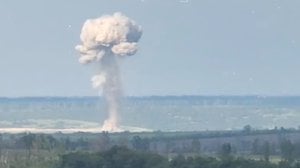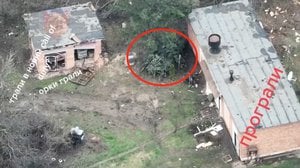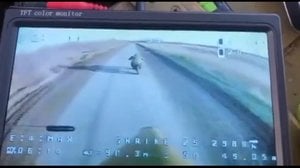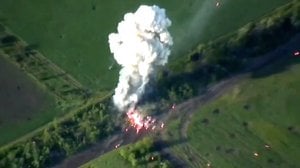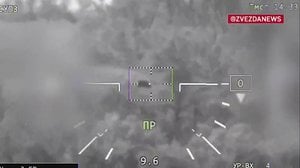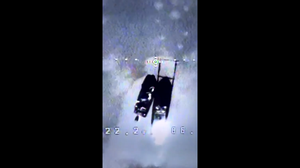
(NSFW) Russian Squad Dismembered by UA Artillery
Published 1 years ago
Is the Ukrainian Army overly dependent on drones for reconnaissance and artillery observation? According to the Washington Post, the U.S. Department of Defense thinks so, but both the Ukrainian Army and their Russian adversaries may think otherwise. This Ukrainian drone footage shows a Russian squad decimated by artillery fires observed and adjusted by drone observers. The squad moves from the top of the screen to the bottom, adequately using shell craters and microterrain for defilade, when mortar or artillery fire lands nearly on top of their position. One of the Russian squad members stops to check on a fallen teammate, and then continues moving with the rest of the squad towards the bottom of the screen. Another round lands and the remaining Russian soldiers fall, apparently cut down by shrapnel.
There are many videos of drone directed IDF, but this particular video offers an opportunity to debate two subjects relating to tactics. The first relates to shell-fuse combination when engaging infantry in the open. The decision to give the Ukrainian Army artillery delivered cluster munitions has been the subject of debate and excessive hype, with some questioning the ethics of the decision, and others declaring it a weapon that will provide a decisive advantage. I admit that munitions such as 155mm DPICM expand Ukrainian capabilities, but certain conventional shell-fuse combinations are better suited for certain tactical scenarios. In this case, a high-explosive (HE) projectile with a variable-time (VT) fuse as a wonderful combination for engaging dismounted troops in the open. The shell bursts about seven meters over the ground, showering everything beneath it with shrapnel, and is a good option against exposed infantry, light vehicles, or targets in trenches without overhead cover.
The second issue of discussion is Ukraine’s use of drone-directed artillery, a development of this war which has proved particularly effective. A Washington Post opinion piece dated 27 August, referenced Pentagon sources supposedly frustrated with the progress of Ukraine’s offensive and with some of their tactical choices, such as the profligate use of drones to identify enemy targets and to observe and adjust artillery fires. While this method has been used effectively by Ukraine, according the WaPo, Pentagon observers want Ukraine to utilize ground reconnaissance forces. As a traditionalist I both see the utility in conventional methods and believe that they remain the bedrock of current and future doctrine, but in this case I struggle to see the utility of conventional means in the tactical scenario faced by the Ukrainian Army.
In conventional conflict, units can deploy reconnaissance teams to infiltrate enemy forward areas, observe enemy areas of interest, report on enemy dispositions, and possibly direct IDF on enemy targets. Units can dispatch dismounted reconnaissance patrols to identify the forward line of troops, and to call for fire on enemy positions. Finally, a unit can fight for information by employing heavy reconnaissance assets, such as U.S. Marine Corps Light Armored Reconnaissance or U.S. Army armored cavalry. The former two methods rely heavily on stealth, and small reconnaissance teams must remain clandestine to be effective. This is problematic on the battlefields in Ukraine, where the proliferation of drones practically ensures detection, and a team that did manage to successfully infiltrate behind Russian lines would be difficult to resupply or extract. As for reconnaissance in force, this approach is of dubious value against a defense of mine fields and fortifications with interlocking fields of fire. A calvary squadron attempting to advance and observe in this instance would experience significant casualties for marginal gains.
I do believe that the use of ground forces for reconnaissance and fire direction is an essential skill that must not be abandoned. In a war of movement, reconnaissance is essential to ensure that the main effort can arrive at the correct place and time to engage in that decisive action that can shatter enemy cohesion. One of my greatest criticisms of the Russian invasion last February was their complete abandonment of traditional doctrine and their failure to engage in any recognizable reconnaissance effort, instead opting to shove armored brigades and divisions along axes of advance in the hope that some of them would eventually arrive at their objectives. It is also possible, even likely, that countermeasures will develop that limit the utility of drone reconnaissance and observation. Until that time, the skillful employment of drones has granted the Ukrainian Army an effective tool that has permitted accurate fires while reducing the risk to human observers.
About the Author

Cam
Cam served as an infantry officer in the Marine Corps, deploying to the Horn of Africa and participating in combat operations in Iraq. He currently works in the maritime industry and in the defense sector as an instructor of combined arms planning and operations. An avid sailor, Cam founded and directs a nonprofit that supports veterans and first responders through sailing.



